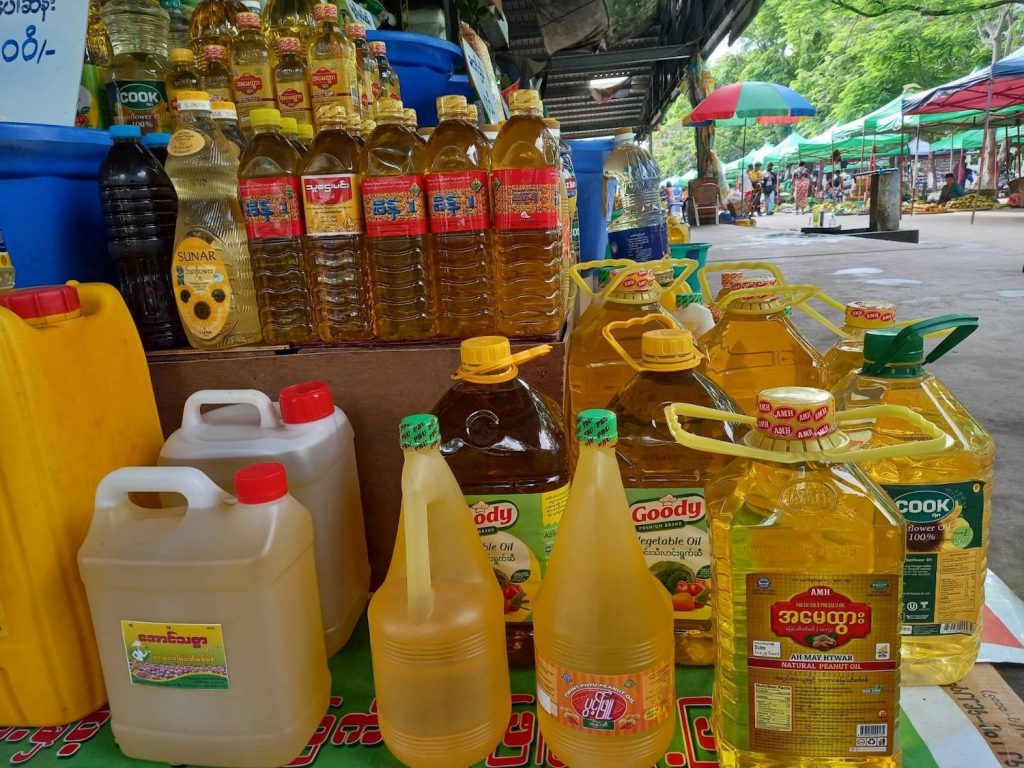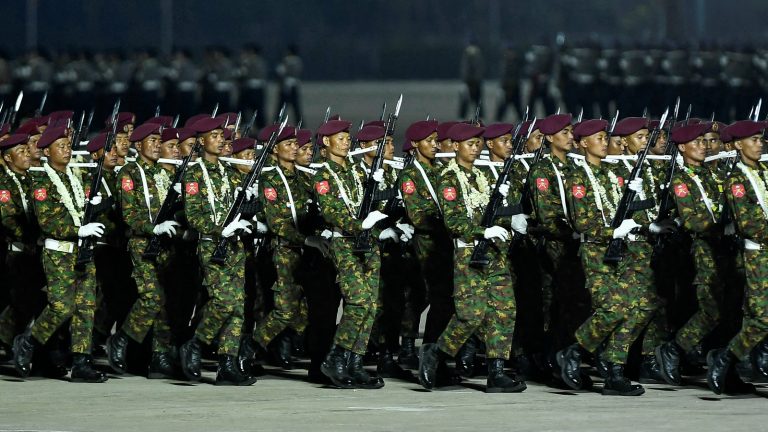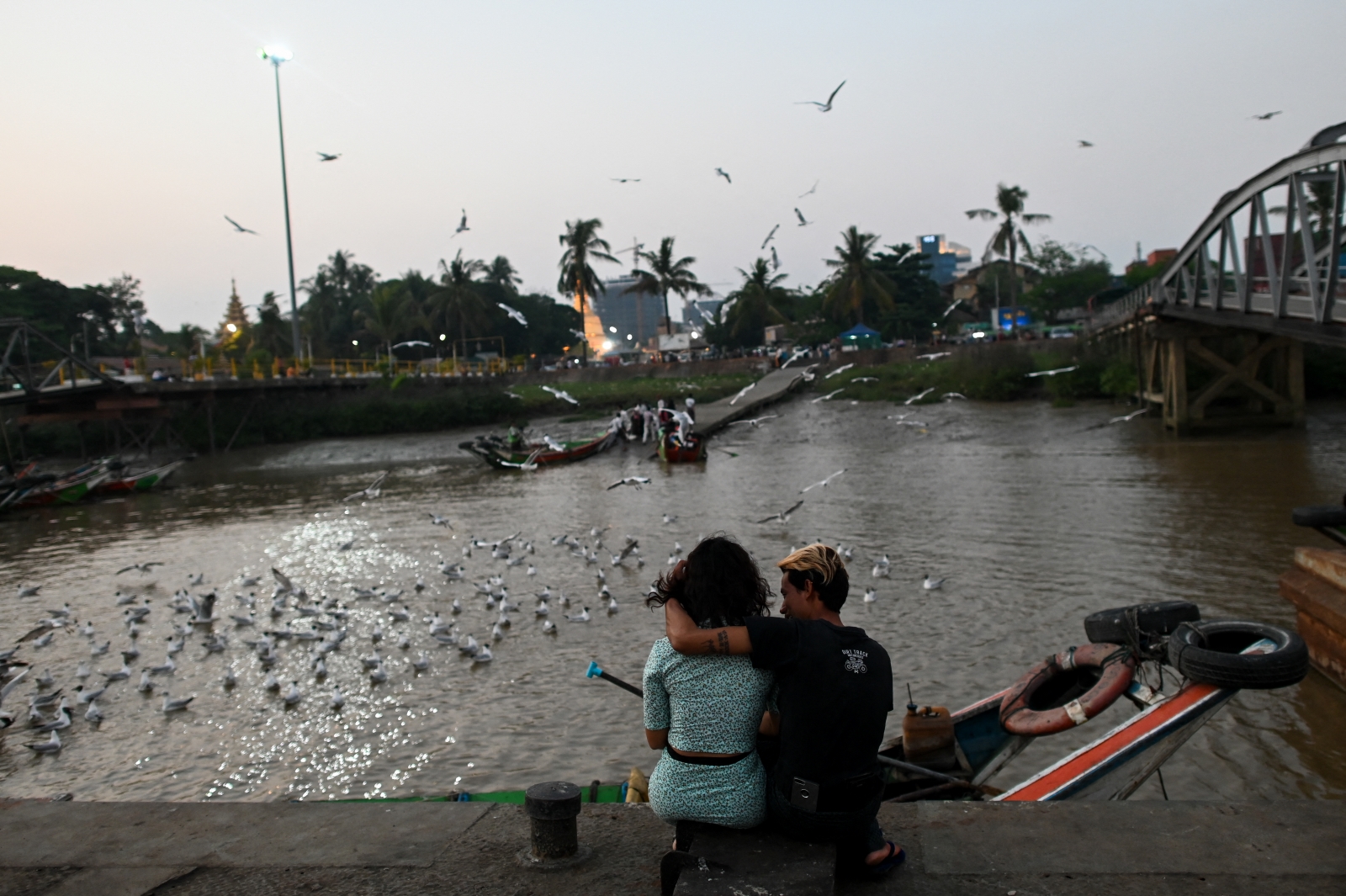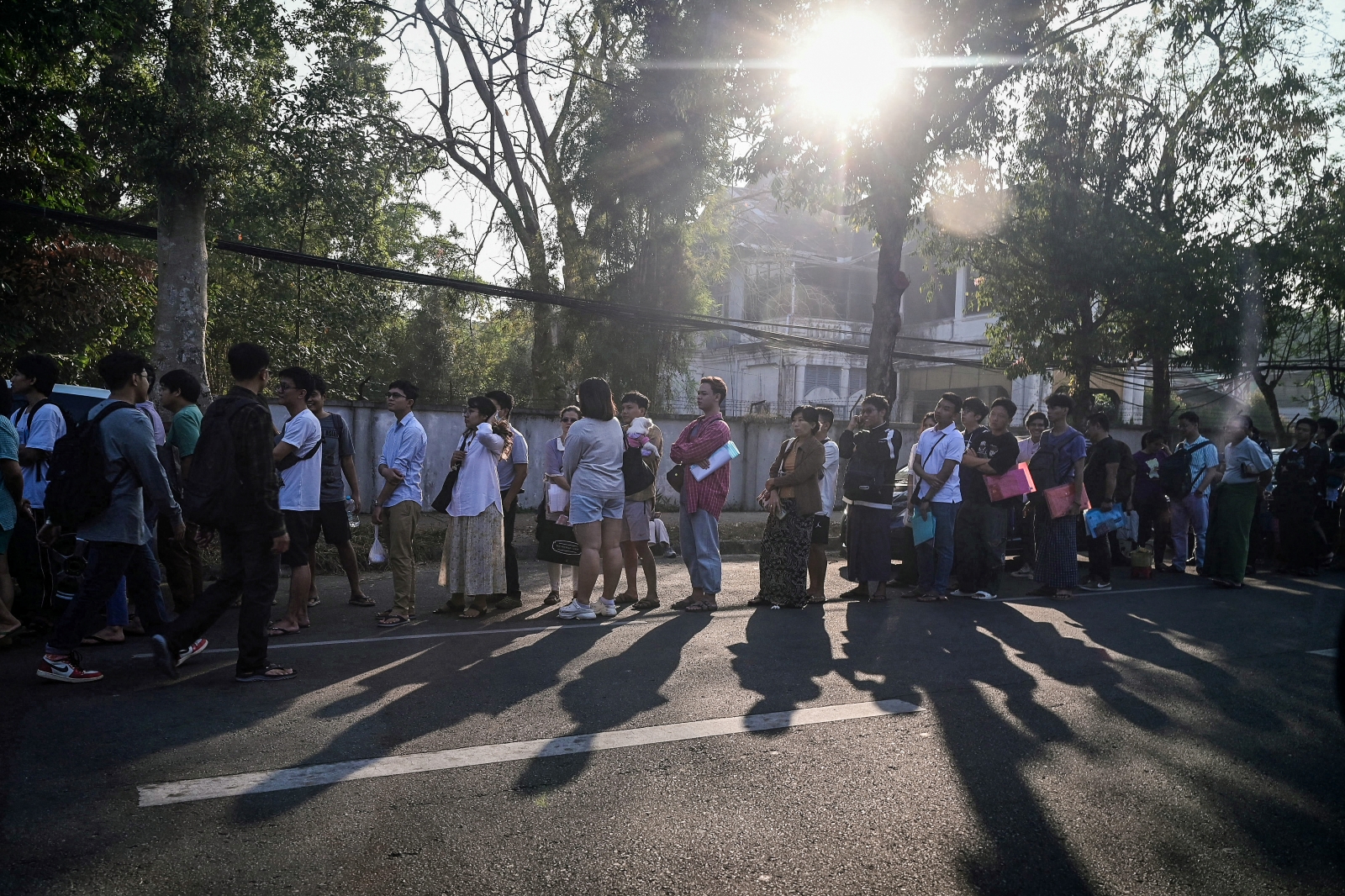The regime’s decision to set an import quota on palm oil has sent edible oil prices skyrocketing, and with domestic production yet to fill the gap, impoverished families have been left with little choice but to cut back.
By FRONTIER
If state media is any indication, edible oil is never far from Senior General Min Aung Hlaing’s mind. Barely three weeks after the military coup, as protests swelled around the country, he expounded on the need to cut oil intake for health reasons. Left unstated was the country’s US$1 billion annual bill for palm oil imports, which he apparently deemed unaffordable as an economic crisis enveloped the country.
Whether presiding over meetings in Nay Pyi Taw or lecturing local officials on his visits around the country, Min Aung Hlaing has returned to the topic of edible oil – and other dietary habits – on a regular basis. His rambling speech marking the nine-month anniversary of his coup administration, in which he asked people to cut back on rice and cooking oil, provoked widespread mockery. Apparently undeterred, he has made food sufficiency one of his regime’s two stated visions, along with “the prosperity of the nation”, and repeated it ad nauseum.
But when it comes to edible oil, this “vision” is more than just talk. Over the past six months in particular, the junta has started putting policies in place to reshape the edible oil sector, affecting everyone from farmers and traders to consumers.
He has drawn heavily on policies of past military regimes, when foreign trade was curtailed to support local production and farmers were pressured into chasing ill-considered cultivation targets. As with other sectors of the economy, such as fuel imports, the present regime has quickly reversed a decade of liberalisation in oil crops that has benefited not just the economy but also many low-income households. The past decade enabled people to access cheaper imports and earn more by selling their produce for export, where they could earn higher prices.
With imports capped, the price of both imported and domestically produced edible oils has soared further. This is simple supply and demand: the regime is rationing foreign currency, creating a shortage of edible oils that is pushing prices up. Its efforts to set a “reference rate” based on the export price have largely failed.
“If you don’t have enough supplies, prices will go up – that’s simply how markets work. You can’t really control it,” observed one agricultural economist, speaking on condition of anonymity. “If you starve the market of palm oil, it’s not like something else will just appear to take over.”
At a time when many households are barely getting by, increasingly price-sensitive consumers have been left with little choice but to simply cut back. Although Min Aung Hlaing has touted the health benefits of reduced palm oil consumption, his policies could have serious health consequences for the country’s poorest.
“Oil is now so expensive relative to consumer purchasing power – you’re talking about a situation in which more than half the country is below the poverty line,” the agricultural economist said. “Vegetable oil is really important for vitamin A absorption … the dietary implications are quite serious.”
Opening up
When President U Thein Sein came to power in 2011, one of his first reforms was to lift restrictions on palm oil imports, which the former military regime had capped at 240,000 tonnes a year. Imports grew rapidly before stabilising at between 800,000 and 1 million tonnes a year.
Myanmar’s annual cooking oil consumption is thought to be around 1.1 million tonnes, of which the vast majority is palm oil imported from Indonesia. The remaining demand is met with other imports and domestically produced oils, mainly peanut (groundnut), sesame and sunflower oil.
Imports tend to be far cheaper than local products, so the trade liberalisation helped make cooking oil more affordable for many households. And as Myanmar’s economy grew, with investment flowing in and garments, gas and agricultural products flowing out, the cost of palm oil imports was never seen as a problem.
But the coup has induced an economic crisis at the time when prices for key imports, including palm oil and fuel, are rising sharply. This has strained the country’s finances and prompted the regime to pursue an import substitution policy. An almost perfect storm has conspired to send prices of many goods skyrocketing. “If you had to pick a time to crash the economy, you couldn’t have picked a worse time,” said the agricultural economist.
Over the past two years, the global palm oil price has more than doubled in US dollar terms, to above US$1,000 per metric tonne. At the same time, Myanmar’s currency, the kyat, has lost about 50 percent of its value against the dollar. As a result, prices have risen from about K3,500 per viss (1.6 kilograms/litres) to K8,000. Go back a few years further, prior to COVID-19, and the domestic price was just K2,000 a viss – a quarter of its current level.
In an attempt to soften the impact of rising prices, the regime sold off tens of millions of dollars of hard currency to palm oil importers in the second half of 2021 at a preferential exchange rate of K1,750, but to little effect. At the end of last year it changed approach, reintroducing a quota on palm oil imports, setting a cap of 50,000 tonnes a month, or 600,000 tonnes a year.
Then, in early April, the regime froze most foreign currency holdings at private banks and fixed the exchange rate at K1,850 to the dollar. To pay overseas suppliers, businesses now need to seek approval from a new Foreign Exchange Supervisory Committee overseen by a senior regime official, Lieutenant-General Moe Myint Tun. Although edible oil is among five priority items, approvals from the committee remain sluggish and the process is mired in red tape.
In recent months, even reaching that 50,000-tonnes-a-month limit has proven difficult due to the fallout from the Russian invasion of Ukraine. Both countries are major sunflower oil producers and the war has disrupted exports, which has in turn created volatility in the palm oil market.
On April 28, Indonesia, the world’s top producer and the source of most of Myanmar’s palm oil, announced a ban on exports to dampen domestic prices; while this was rescinded on May 23, Indonesia’s exports are yet to recover, in part due to a new export approvals process.
On May 10, the Myanmar Edible Oil Dealers’ Association announced that there were just 18,000 tonnes of palm oil left in storage tanks, and it would not allow companies to withdraw supplies. Although Indonesia has resumed exports, association vice chair U Ye Thu Aung told Frontier that supplies could be delayed.
“Although Indonesia has re-allowed palm oil exports, some of their rules are not clear so imports will not resume as soon as we hoped. There could be some delays,” he said.
Palm oil imports to Myanmar have since resumed, with state media reporting that three vessels containing a total of more than 18,000 tonnes of oil docked between June 10 and 17, and both global and domestic prices have declined slightly.
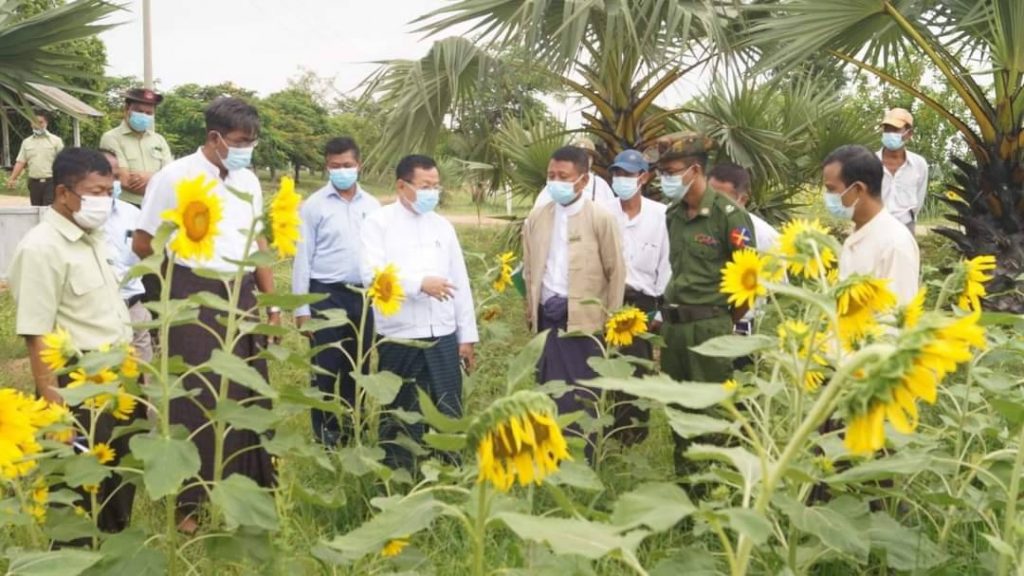
Filling the gap
If there has been a winner from high palm oil prices and the regime’s import restrictions, it is locally produced edible oils, particularly peanut and sesame. Although these have always been preferred by consumers, most opted for palm oil because it was so much cheaper. As a result, much of Myanmar’s oil crop production was exported and domestic oil production languished.
With locally produced oils now priced similarly to palm oil, they have enjoyed a reversal in fortunes; idle oil mills in Myanmar have been pressed back into service, entrepreneurs are investing in new equipment and crop prices have soared on the back of domestic demand.
A Pyinmana Township resident told Frontier she had changed from palm oil to a locally produced oil blend because it was K500 cheaper. “For now, we’re still using the same amount of oil, but it’s a struggle to make ends meet,” said the mother of three. “I don’t expect it to change – once commodity prices go up, they never seem to fall again.”
To ensure more of Myanmar’s oil crop production goes to meeting domestic needs, the junta’s Ministry of Commerce on May 9 announced a temporary suspension of oil crop exports through Myawaddy, a border trade point on the border with Thailand. Two weeks later the ministry’s Trade Department said that export licences will be required from August 1 to send beans, pulses and oil crops abroad.
In March the junta’s Ministry of Agriculture, Livestock and Irrigation began pushing a massive expansion of sunflower cultivation in an effort to increase local edible oil production. According to the Department of Agriculture, the junta has set guidelines to expand oil crop acreage so that Myanmar is self-sufficient in edible oil.
U Myo Tint Htun, the ministry’s deputy permanent secretary, told Frontier that the target was to increase sunflower cultivation from 600,000 acres to 1.5 million acres this fiscal year. Sunflowers are generally a winter crop, grown after the paddy harvest towards the end of the calendar year.
The expansion is focused mainly for Sagaing, Mandalay and Magway regions, Myo Tint Htun said. While he declined to give the targets for each region, state media has published some figures in recent months as officials get behind the sunflower campaign. The Department of Agriculture also said in a recent statement that almost 360,000 acres of sunflower were grown in Sagaing Region in 2021-22, and another 34,000 would be added this financial year – seemingly far short of what would be needed to hit the regime’s target.
Myo Tint Htun said the campaign was both to improve health, because sunflower oil is healthier than palm oil, and to meet domestic demand for edible oil in light of the import restrictions.
“Sunflowers are also more feasible [to grow] than other oil crops, but farmers will also continue to grow peanut and sesame as usual,” he said.
Although there have been reports in local media of farmers being pressured into growing sunflowers to meet regime targets, Myo Tint Htun said they would only be “encouraged” to cultivate the oil crop.
“They will only do it if they can make a profit, but in the current global situation edible oil prices are rising so they should make money,” he said. “Our department will provide them with high-yield seed varieties, technology and agricultural loans.”
Not so bright
For many farmers, though, sunflowers are an unattractive prospect. Among oil crops, sunflower is a distant third behind sesame and peanut, of which farmers grow 3.8 million acres and 2.8 million acres, respectively, each year.
For the most part, it is simple economics: sunflower fetched K30,000 acres a basket last year compared to over K50,000 a basket for peanut and sesame, farmers told Frontier.
The differential is due to the lower retail price and yield. A basket of sunflower seeds yields about 4 viss of oil, while peanut and sesame produce about 5 viss and the oil sells at a premium to sunflower oil.
“Sunflower is also less predictable [than sesame and peanut],” said U Tin Aung, who cultivates 12 acres in Magway Region’s Myaing Township. “If the weather is right, the harvest isn’t too bad. But if the weather is unfavourable, you can lose everything. That’s why farmers dare not grow sunflowers as their major crop.”
Farmers have learned this the hard way. “In the time of Than Shwe, the retired senior general, sunflowers were once widely grown,” said U Ko Ko Naing, a farmer who works 15 acres in Mandalay Region’s Patheingyi Township.
“There were slogans: ‘To achieve definite success, grow sunflowers. Whatever you grow, don’t forget to add sunflowers.’ But regardless of the slogans, sunflowers were not profitable so farmers stopped growing them and the plan wasn’t successful. I don’t know what will happen this time but I have no intention of growing sunflowers.”
Seed quality can also make a significant difference. The Department of Agriculture estimates that an acre of high-yielding sunflower can produce 50 baskets of sunflower seeds but Tin Aung, the farmer from Myaing, said he got just eight baskets an acre from his crop last year.
State media has reported regularly on agriculture ministry efforts to grow sunflower seeds during monsoon season for distribution later this year, with thousands of acres nationally dedicated to this purpose.
Agriculture ministry official Myo Tint Tun said the efforts would still not be enough, and arrangements are being made to import seeds from India.
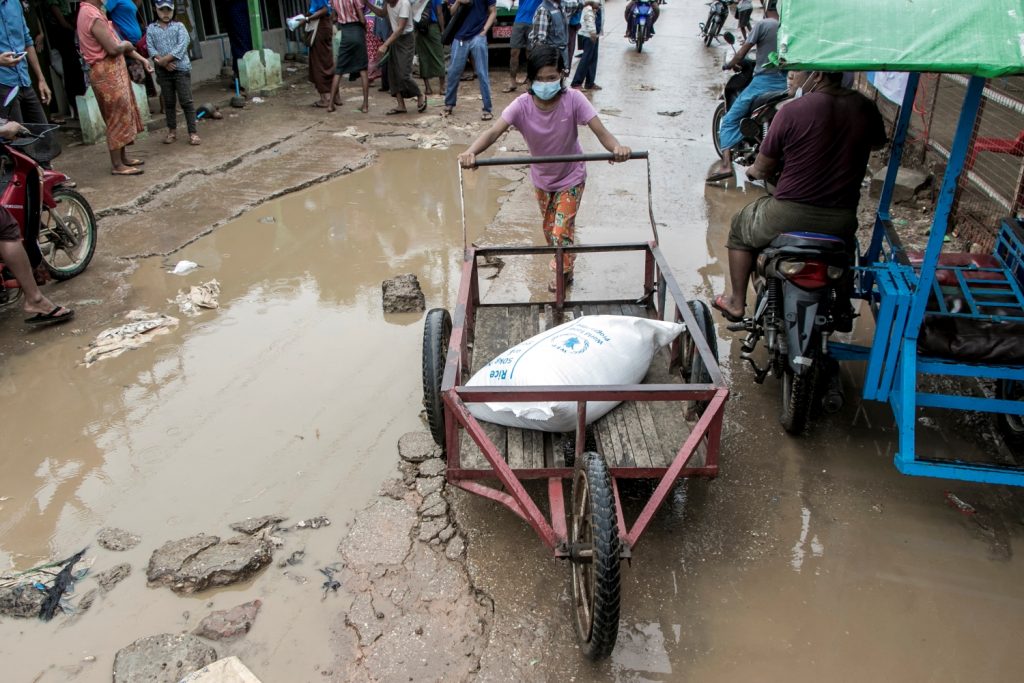
Squeezing the poorest
Even if the regime is able to hit its sunflower cultivation targets, which seems unlikely given the logistical hurdles and farmers’ reticence to grow the crop, it will not be enough to compensate for the reduction in palm oil imports. The junta is also encouraging increased domestic palm oil production – an initiative that, like sunflower cultivation, was pushed by the former military regime and was largely a failure – but even if successful will take years to eventuate.
U Ye Thu Aung, vice chair of the Yangon Region Edible Oil Dealers’ Association, claimed that the solution was a combination of increased domestic production and lower consumption – echoing the arguments of Min Aung Hlaing.
“We should grow more oil crops and produce edible oils that are both good quality and low cost – then the country will be ok,” he said. “But people should also change their unhealthy dietary habits and try to reduce oil consumption.”
Ye Thu Aung insisted the gap between imported and locally made oil was now relatively small. “People should consume more locally produced edible oils than imported palm oil because the prices aren’t that much different anymore,” he said.
Asked about the feasibility of increasing edible oil production, he said that growers and producers would respond to the changes in policy in order to meet demand, and that the regime was supporting domestic production by reducing imports.
“Anyway, we cannot import as much palm oil as much as we want like we did before. We will be on track sooner or later,” he said.
But for consumers who are already struggling – and the effects of COVID-19 and the coup have pushed millions back into poverty – import caps are only likely to exacerbate the financial pain.
A resident from Zabuthiri Township in Nay Pyi Taw said customers would prefer local products, but most are very price sensitive and will go with the cheapest option.
“Pure peanut and sesame oils are just too expensive for us. If you are struggling, even saving K1,000 is a lot,” they said.
Another Zabuthiri resident said that when palm oil prices hit K7,200 a viss, she had cut back from 4 viss to 3 viss a month for her family of five. She is now spending about 8pc of the household’s average monthly income on edible oil.
“These days we can’t use too much oil when we cook,” she said. “Rising commodity prices are hard for low-income people like us. I don’t have anything to say – I just want to see Min Aung Hlaing fall quickly.”


